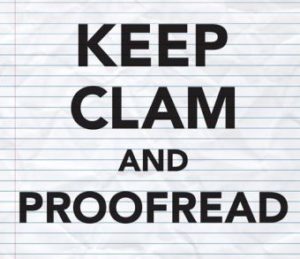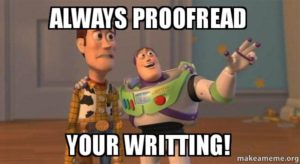What is Proofreading and how you can do it?
Proofreading is the process of reviewing and correcting text for errors, typos, and inconsistencies. It is an important step in the editing process and can help to improve the overall quality of a document. Proofreading can be done by hand or using a proofreading tool or software. In this article, we will discuss how to proofread text manually, as well as how to use a proofreading tool or software.
- What is proofreading?
- The difference between proofreading and editing
- What is the importance of proofreading?
- Working with professional proofreaders
- How can you proofread by yourself?
- Proofreading tools you can use
- Tips for proofreading effectively
- Common mistakes people make when proofreading and how to avoid them
What is proofreading?
Proofreading is the final step in writing a book before it is published. It sets the tone for what will be seen by readers, as writers need to ensure that their work follows a certain level of quality and accuracy.
Proofreading involves checking what has been written for any spelling, grammar, or punctuation errors, but also includes understanding what facts are in the document and double-checking them.

This additional assurance of what is written is what is meant by proof. Without proofreading, mistakes can be left that may make a piece of writing look unprofessional and might result in miscommunication with an audience.
It also helps authors spot sentences or ideas that don’t work, allowing them to receive more accurate feedback from editors and peers who read their work. In summary, proofreading provides an important service for writers ensuring their documents are refined to a high standard before publication.
The difference between proofreading and editing
Editing and proofreading are two essential components of bringing written work up to a professional standard. While both involve closely examining the text for potential edits and errors, there is an important difference between editing and proofreading that many people overlook.
Editing
Editing is focused on honing content and structure, making sure the pieces fit together logically and are coherent from beginning to end. It involves reworking sentences or paragraphs at a larger scale to make them more concise and readable.
Proofreading
Proofreading, on the other hand, is about eliminating typos and errors, and ensuring grammar and punctuation rules have been followed correctly. It doesn’t focus on correcting any larger conceptual issues but instead scrutinizes words individually to snag any mistakes that might otherwise be overlooked. Ultimately, while editing lays out the structure of the piece, proofreading gives it its final polish before publishing.
What is the importance of proofreading?
Proofreading is a vital step in the writing process, ensuring not only accuracy but also clarity. It provides endless advantages; the importance of properly proofreading your work cannot be underestimated.
From double-checking spelling and grammar to identifying poor phrasing choices, proofreading allows authors to self-edit and make their writing as effective as possible.

Many writers are aware of the importance of proofreading in terms of correctness, however, they may not understand how effective it can be for improving nuance or even changing a document’s structure entirely.
Done correctly, proofreading should involve going over your piece several times and looking at it from different perspectives so that any errors are caught before it’s too late. After all, a few corrections can make all the difference to how your written work is received by its final audience!
Working with professional proofreaders
Working with professional proofreaders can be a great asset for anyone looking to improve their writing. Working with a proofreader can help produce professional-quality documents with an eye for formatting, grammar, and punctuation.
Professional proofreaders can identify inconsistencies within the text and provide helpful guidance on how to enhance its clarity and polish.
Furthermore, professional proofreaders can also provide valuable feedback on the effectiveness of your arguments and the strength of logical transitions between ideas – something which often gets overlooked in one’s initial drafts.
Ultimately, professional proofreaders offer an invaluable service to everyone who wants to write better and make sure their written works stand out from the crowd.
Pros and Cons of working with a professional proofreader
Hiring professional proofreaders to review written materials comes with pros and cons. On the plus side, a professional proofreader owns expertise in spotting and fixing errors in grammar, spelling, and punctuation.
They also look out for typos, inconsistencies, and redundancies in a piece of writing that escape casual readers. Another advantage is their ability to improve their style of writing by ensuring sentences are concise yet well-crafted.
In addition, professional proofreaders can often catch more subtle errors such as confusion between homonyms or incorrect word choices in your piece of writing.
However, professional services involving a proofreader come with a cost attached which may be out of reach for some people. Moreover, there may be a language barrier if the professional is not a native speaker of the source material’s language.
Finally, even professional proofreaders can make errors– they cannot guarantee error-free work but they can certainly reduce mistakes significantly.
How can you proofread by yourself?
One of the best ways to proofread your writing is to do it yourself. Proofreading your work can be incredibly useful for ensuring quality and accuracy in any type of writing, from memos to articles.
Steps involved in proofreading your work
One way to proofread yourself is by reading aloud. This helps you become aware of any typos or grammar mistakes that you may have missed while proofreading silently.
As you read, take note of each sentence or paragraph and think about the structure, flow, and content of your writing. Pay attention to words that sound repetitive and edit those accordingly. Another way to proofread your work is by leaving a day or two between edits.
This will give you a fresh perspective on what needs to be improved in terms of content, grammar, proofreading errors, organization, and more.
Finally, try enlisting the help of someone else as they may pick up on things that you have not noticed while proofreading yourself. With these simple-yet-effective tips, proofreading your writing can be made a lot easier!
Pros and Cons of proofreading on your own
When proofreading your work, doing it yourself to some degree has its advantages and disadvantages. One of the major advantages is that proofreading on your own allows you to dig deep into your work.
You can assess every single aspect in detail, allowing you to correct minor errors that may have been easily overlooked if proofreading was done by someone else. Indeed, proofreading done by you can make a huge difference between an excellent document versus a mediocre one.
On the other hand, proofreading by yourself also presents its challenges. Since you are the author and have worked with immense dedication during the entire writing process, proofreading your work can become challenging as biases or overlooking errors may occur.
To offset this problem, it is important to take breaks from proofing or enlist someone else such as a friend or family member to review it for any possible errors. Taking into consideration both pros and cons of proofreading by itself will ensure great outcomes when producing documents.
Proofreading tools you can use
Proofreading is an indispensable step to ensure successful writing and publishing. There are effective proofreading tools and software out there that can help you proofread articles, blog posts, books, or any kind of written material with ease. Two of the most widely used proofreading tools are Grammarly and ProWritingAid.
With Grammarly, users can access a comprehensive online grammar and spelling checker, making it easy to write effectively without sacrificing style.

ProWritingAid offers an AI-powered review offering proofreading suggestions covering everything from grammar and punctuation to content structure and readability.

Both proofreading tools allow users to make corrections directly in their documents for ultimate convenience. For maximum accuracy, it’s best to proofread your work manually as well, since no proofreading tool or software should replace real human intelligence when it comes down to checking for errors in a text.
Tips for proofreading effectively
Effective proofreading is one of the most important steps in the writing process, as it can help you achieve a polished, professional final product.
To make sure your document is free from typos and mistakes, these tips for proofreading are essential.
Proofreading tips you can use
First, take a break from your writing to give yourself some distance from it so you can be more clearly focused when you review it.
Secondly, work slowly so that you can read word-by-word and check for punctuation errors or incorrect grammar usage.
Lastly, try reading aloud; this audial interpretation will help you identify any awkward phrases that don’t flow naturally. By considering these tips for proofreading effectively, you’ll be able to review your document more thoroughly and catch key details you may have missed when reviewing it silently.
Common mistakes people make when proofreading and how to avoid them
Proofreading is a crucial process that can make or break a written piece. Even seasoned writers make mistakes when proofreading, but learning to recognize and avoid common proofreading errors can help you ensure your work is error-free and accurate instead of careless and rushed.
Frequent proofreading mistakes
Two of the most frequent proofreading blunders are not proofreading thoroughly enough and proofreading too quickly. Too often people will proofread their work on autopilot, missing critical details due to carelessness or familiarity with the text. Learning to take your time when proofreading is essential, as it allows you to catch mistakes early before they become bigger issues or create unnecessary frustrations.
Additionally, writers should always pay close attention when double-checking grammatical elements, such as spelling, punctuation, particle placement, and formatting of numbers and letters—all of which are elements that can be easily overlooked during proofreading sessions.
Avoiding proofreading mistakes
To avoid these common proofreading mistakes and ensure your critical eye captures every detail in its entirety you should take breaks throughout proofing so you can remain focused on the task at hand; this goes especially true for longer pieces like essays or books.
Keeping an eye out for these common proofreading missteps will help creators produce more polished and engaging works of writing.
Although proofreading can be daunting at first, it doesn’t take long to get the hang of it—and afterward, you’ll undoubtedly notice an improvement in clarity, versatility, and the overall quality of your written works.
Take the time to proofread your materials thoroughly, and dedicated readers will surely appreciate that extra attention to detail.

